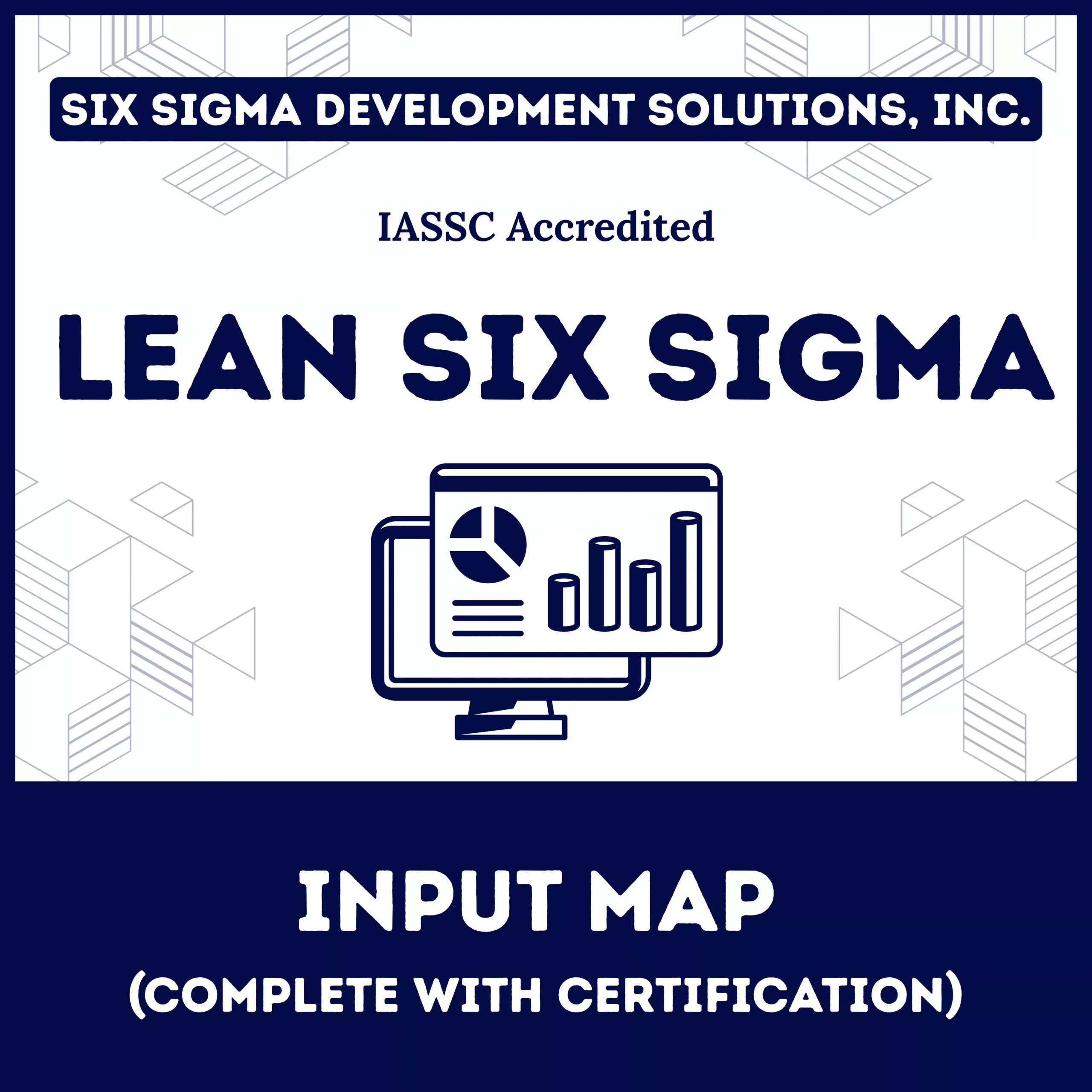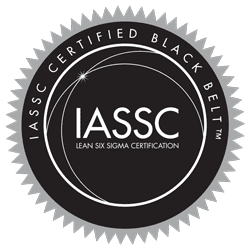Description
Input Map Online Training Course
Master the X’s That Drive Your Y in 60 Minutes
Struggling to identify the critical factors affecting your process outputs? Input Map training is the essential tool for translating the Six Sigma equation Y=f(X) into actionable improvement. This comprehensive 60-minute video course teaches you to systematically identify, document, and categorize all process variables that influence your desired outputs. Learn to distinguish controllable from uncontrollable variables, then focus improvement efforts on the X’s that truly matter.
What You’ll Learn
Understanding Variables: The Input Map Foundation
Grasp the fundamental Six Sigma principle: your output (Y) is a function of your inputs (X). Before you can optimize results, you must define all variables affecting your process. Input Map training translates this concept into a practical, visual tool.
Input Map Step 1: Document Process Steps
Map your process into clear, logical steps (ideally 12 or fewer). If you exceed 12 steps, your project scope may be too broad. Learn to break complex processes into manageable components that drive outputs. These steps become the foundation for input identification.
Input Map Step 2: Identify Measurable Outputs
Document what your process produces and how you measure success. Outputs connect directly to process steps, not inputs. Understand why a single process can have multiple inputs feeding just a few critical outputs.
Input Map Step 3: Capture All Process Variables
Walk the actual process (Go to Gemba), observe carefully, and document every input systematically. Learn to express inputs as concise three-word nouns (not adjectives or adverbs). Importantly, capture all potential inputs now. You’ll filter insignificant ones later using the Cause & Effect Matrix.
Input Map Step 4: Classify Variables as Controllable or Uncontrollable
Distinguish between controllable inputs (C)—factors you can adjust during process operation—and uncontrollable inputs (U)—factors beyond your control or influence. Controllable variables become your improvement focus. Understanding what you can actually change is critical for realistic improvement planning.
Real-World Examples
Apply Input Map concepts using relatable examples like lawn mowing. Controllable variables include mower height and pushing speed. Uncontrollable variables include weather conditions. This practical framing makes abstract concepts concrete and immediately applicable.
Course Format and Certification
- Duration: 60 minutes of expert-led video training
- Delivery: Self-paced online access anytime, anywhere
- Interactive Learning: Complete Input Map assignment identifying critical variables for your process
- Downloadable Template: Free Input Map template included
- Assessment: Final quiz validating your comprehension
- Certification: Immediate Certificate of Completion upon passing
Why Input Map Training Matters
Input Map development is essential because it:
✅ Identifies critical variables – Uncovers all X’s influencing your Y
✅ Focuses improvement efforts – Targets controllable variables delivering maximum impact
✅ Prevents data overload – Systematically filters variables before analysis
✅ Guides experimentation – Provides clear direction for design of experiments
✅ Improves decision-making – Clarifies what factors you can actually change
✅ Bridges Measure and Analyze – Connects data collection to root cause identification
✅ Supports prioritization – Works with C&E Matrix to identify vital few variables
Without systematic Input Map development, teams waste resources chasing insignificant variables while overlooking true drivers of performance.
The Four-Step Input Map Development Process
Input Map Step 1: List Process Steps
Document 5-12 high-level steps from your SIPOC process definition. Each step should represent a major transformation of material, information, or service.
Input Map Step 2: Define Measurable Outputs
Identify what each process step produces and how you measure it. Outputs should be specific, measurable, and directly connected to customer requirements.
Input Map Step 3: Document All Process Inputs
Go to Gemba and physically observe your process. Capture every input feeding each step using three-word noun descriptions. Resist filtering—the C&E Matrix handles prioritization later.
Input Map Step 4: Classify Variables as Controllable or Uncontrollable
Mark each input as C (Controllable—you can adjust it) or U (Uncontrollable—beyond your control or cost-prohibitive). Focus improvement on controllable variables offering leverage.
Who Should Take This Course?
- Six Sigma Green Belts: Professionals leading Measure and Analyze phase activities
- Six Sigma Black Belts: Experts designing experiments and analyzing root causes
- Process Analysts: Specialists identifying variables affecting process performance
- Quality Engineers: Professionals optimizing production and service processes
- Continuous Improvement Teams: Cross-functional groups targeting key performance drivers
- Operations Managers: Leaders seeking data-driven approaches to process optimization
- Anyone tackling complex processes where multiple variables influence outcomes
Real-World Applications
Apply Input Map training across industries and functions:
- Manufacturing: Identifying factors affecting product quality, yield, or cycle time
- Healthcare: Determining variables influencing patient outcomes or treatment effectiveness
- Financial Services: Understanding inputs affecting loan processing speed or approval rates
- Call Centers: Identifying factors affecting call resolution time or customer satisfaction
- Retail: Determining variables influencing checkout speed or inventory turnover
- Logistics: Identifying inputs affecting delivery time or shipping accuracy
- Education: Understanding factors affecting student learning outcomes or course completion
How Input Maps Connect to Other Tools
SIPOC: Provides the Process steps for Input Map development
Cause & Effect Matrix: Filters your Input Map to identify the vital few variables
Design of Experiments: Tests relationships between controllable variables and outputs
Statistical Analysis: Quantifies input-output relationships identified through Input Maps
Input Map development is the critical bridge connecting process definition to root cause analysis and improvement experimentation.
About Six Sigma Development Solutions, Inc.
This training is provided by Six Sigma Development Solutions, Inc., an IASSC Accredited Training Organization. Our ATO designation validates courseware quality, consistent delivery methods, and highly qualified instructors aligned with IASSC Bodies of Knowledge.
We’ve transformed 100+ organizations across 52 countries, achieving $100M+ in documented savings. Our 4,000+ certified practitioners and partnerships with industry leaders demonstrate proven expertise in operational excellence.
Enroll Today and Master Input Map Development
Invest 60 minutes to master the systematic approach that translates “Y=f(X)” from theory into practice. Stop guessing which factors truly drive performance. Learn to identify, document, and prioritize the variables that matter most for your process improvement initiatives.
This Input Map training course includes:
- 60-minute expert video training
- Real-world examples and case studies
- Free Input Map template
- Interactive assignment on your process
- Final assessment quiz
- Immediate Certificate of Completion
- Lifetime course access
Start developing Input Maps with confidence. Enroll now and master the tool that bridges process definition and root cause analysis.
Related Courses:
- SIPOC Diagram Online Training
- Value Stream Mapping Training
- Lean Six Sigma Green Belt Certification
- Six Sigma Root Cause Analysis Templates
Questions? Contact us at 866-922-6566 or https://sixsigmadsi.com/contact-us/
Keywords: Input Map, Input Map training, Input Map template, variables map, controllable variables, uncontrollable variables, Six Sigma tools, Y=f(X), root cause analysis, IASSC training, online Six Sigma course, Measure Phase, Analyze Phase, process variables





Reviews
There are no reviews yet.